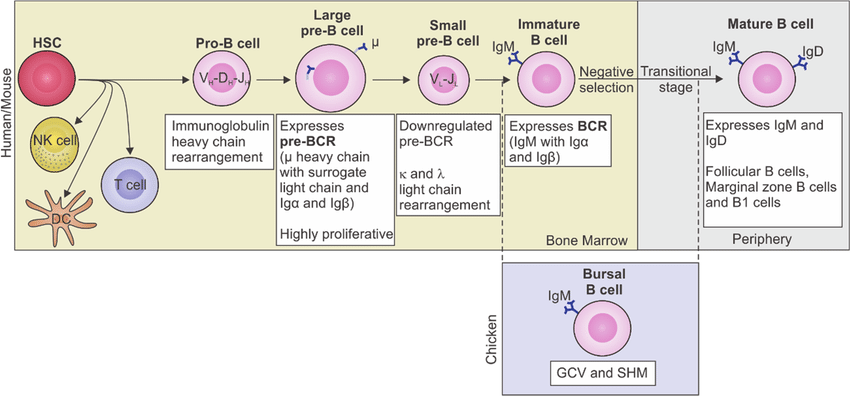Both T and B lymphocytes originate from a common lymphoid progenitor in the bone marrow, but further development of T lymphocytes occurs in the thymus while B lymphocytes develop in the bone marrow (and liver in the fetus).
Development of T cells: Depending on their surface receptors, T cells can be divided into two lineages - alpha, beta T cells and gamma, delta T cells. Alpha, beta T cells are further divided into CD4 and CD8 T cells, depending on the class of MHC that they recognize. CD4 T cells bind to MHC class II while CD8 T cells bind to MHC class I. Early in development, T cells do not express either CD4 or CD8 and are called “double negative” T cells. Thymocytes that express both CD4 and CD8, and are called “double positive” T cells and they are precursors to CD4 and CD8 T cells. Double negative and double positive cells are located in the cortex of the thymus while single positive cells are located in the medulla from where they enter the bloodstream. CD44, c-Kit and CD 25 (receptor for IL 2) are seen in early T cells while CD3 and CD2 are expressed in more mature T cell lineages. Hormones thymosin and thymopoietin help T cell differentiation in the thymus.
Only those thymocytes (T cells) whose receptors can interact with self MHC are selected for survival, a phenomenon called “positive selection”. On the other hand, thymocytes that react against self-antigens undergo “negative selection” and are eliminated. A transcriptional regulator called AIRE or Autoimmune Regulator, enhances the synthesis of an array of self - proteins to be displayed on Thymic epithelial cells which helps in T cell tolerance. Mutations in AIRE cause Autoimmune polyendocrinopathy. Thymic cortical epithelial cells have branching processes that make contact with developing T cells and expose them to MHC molecules, playing an important role in positive selection. Dendritic cells regulate negative selection of self-reactive T cells… Mature, single positive CD4 or CD8 T cells then leave the thymus. CD4+ T cells are also called helper T cells while CD8+ T cells are called cytotoxic T cells.
The CD4 molecule is composed of four domains - D1,2,3 and 4. Domains D1 and D2 are involved in binding to the MHC class II molecule. A CD8 molecule is a heterodimer of one alpha and one beta chain or two alpha chains that are linked to each other. CD8 binds to alpha 3 domain on MHC I. CD4 and CD8 act as co-receptors and bind to MHC II or I, respectively. This binding is essential for an effective immune response.
Development of B cells: Bone marrow stromal cells are essential in the early stages of B cell development. Stromal cells secrete several growth factors like stem cell factor, cytokines and adhesion molecules to help B cell differentiation. Immature B cells have IgM on their surface while mature B cells have IgM and IgD on their surface. B cell surface proteins CD45R and CD19 are expressed in all stages of B cell development. Self-reactive B cells undergo clonal deletion.

Sign up for free to take 2 quiz questions on this topic